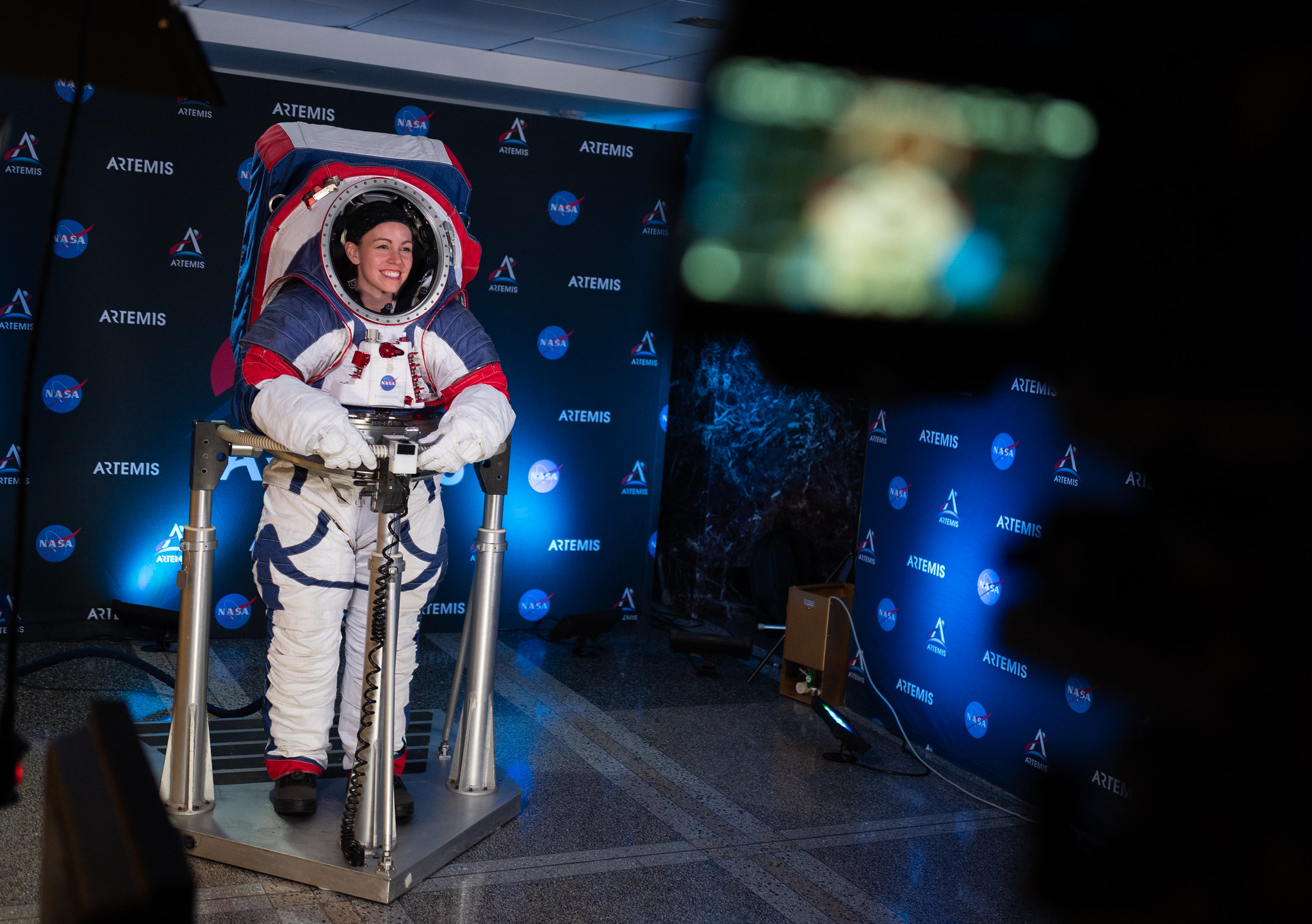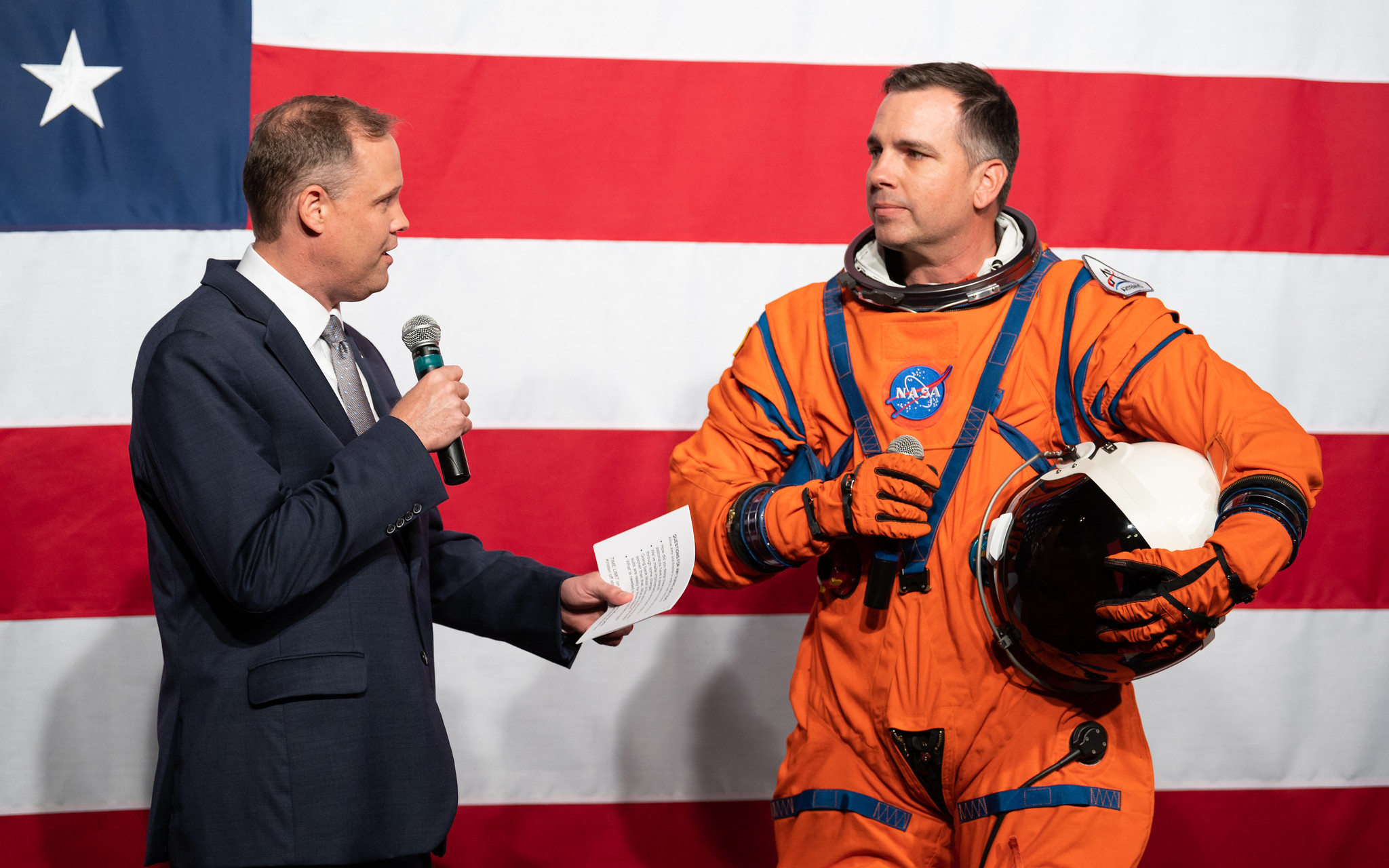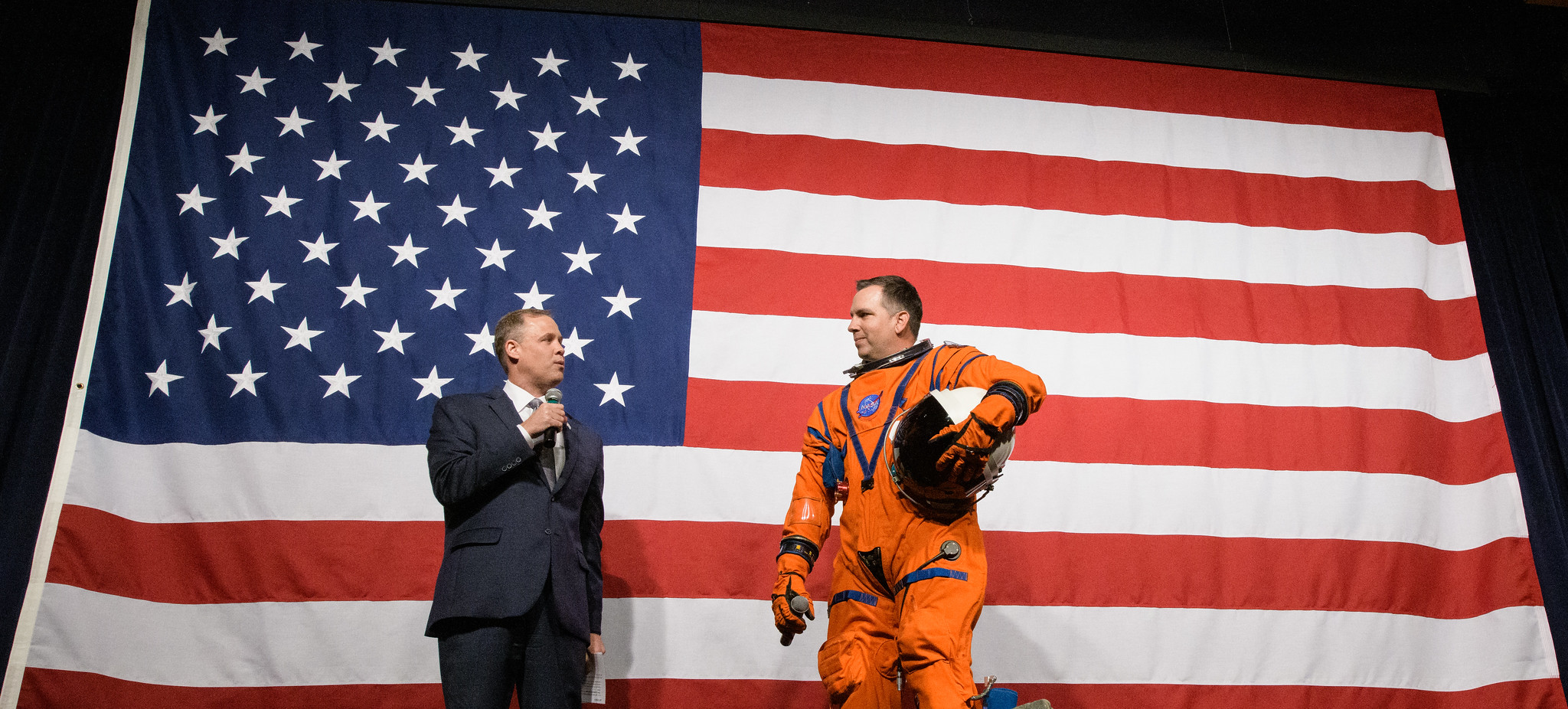NASA Just Unveiled the Spacesuit to be Worn by First Woman on the Moon
WASHINGTON — NASA on Tuesday (Oct. 15) unveiled new prototypes of the spacesuits that will be worn by the first woman to walk on the moon.
In an event at the space agency's headquarters here, NASA chief Jim Bridenstine and spacesuit engineers share the first up-close look at two next-generation spacesuits designed for for the agency's Artemis program, which aims to land the first woman and the next man on the moon by 2024.
"We are going to the moon by 2024 and we want it to be sustainable," NASA Administrator Jim Bridenstine said at the event, adding that the the moon will be a testing ground to propel astronauts to an even farther destination.
"Ultimately the goal is this: we're going to Mars," Bridenstine said. "And in order to go to Mars, we need to use the moon as a proving ground."
Related: Moon 2024: NASA Wants Ideas for Lunar Spacesuit Tech
More: Q&A with NASA's Human Landing System Chief Lisa Watson-Morgan






To reach these ambitious objectives, NASA knows it needs to update its spacesuits so that people of all shapes, sizes and genders will be able to fly to and explore the moon, Mars and beyond.
"Kristine is wearing a spacesuit that will fit all of our astronauts when we go to the moon," Bridenstine said, motioning to Kristine Davis, a spacesuit engineer at NASA's Johnson Space Center, who wore one of the two prototype suits on stage at the event.
Breaking space news, the latest updates on rocket launches, skywatching events and more!
The two spacesuit prototypes which NASA showcased are designed for two separate parts of a crewed mission to the moon. One, called the Exploration Extravehicular Mobility Unit (xEMU) which was worn by Davis, is a red, white and blue suit designed to be worn by astronauts exploring the lunar surface, specifically at the moon's south pole — the target for NASA's next crewed lunar landing.
The second suit unveiled Wednesday, the Orion Crew Survival System, which is a bright orange pressure suit that will be worn by astronauts when they launch into space on the Orion capsule and return to Earth. It was demonstrated at the event by NASA spacesuit engineer Dustin Gohmert.
Related: How NASA Spacesuits Work: EMUs Explained (Infographic)
More: The Evolution of the Spacesuit in Pictures
A new spacesuit for the moon
The xEMU suit will be the first suit worn on the moon's surface since NASA's Apollo program sent the last astronauts to the moon in 1972. The suit includes a number of improvements from both the Apollo era suits and the suit worn by astronauts completing spacewalks from the International Space Station.
One specific improvement is the sizing and fit, NASA engineers said. The xEMU suit is designed to accommodate a wide variety of sizes and NASA intends for it to fit better, be more comfortable and allow astronauts to move around more easily in the suit.
"The mobility is one of the biggest things," NASA astronaut Kate Rubins said at the spacesuit unveiling. "If you need to pick up a rock … if you're planting a scientific instrument, you need that upper torso mobility."
While these improvements will allow astronauts to hopefully work with less discomfort and more mobility, working in a spacesuit designed for extravehicular activity is still a challenge, as it is a pressurized suit in an extreme and difficult environment. Rubins likened a spacewalk to running a marathon.
Now, while the legs on the EMU spacesuits astronauts currently use for spacewalks outside the International Space Station might not be very important (because the astronauts are floating in space, not exploring terrain on foot), the legs on the xEMU will be vital, so careful consideration has been taken to ensure that the suit legs will accommodate relatively easy walking on the moon's surface.
This will hopefully be a major improvement from the Apollo suits, which allowed astronauts only enough mobility to "bunny hop" on the lunar surface.
Additionally, with improved carbon dioxide scrubbing technology, astronauts will be able to spend more time on extravehicular missions — up to 8 hours with an additional extra hour just in case, NASA officials said. The suit will also have improved seams and design to prevent issues with lunar dust, which were a major problem with the Apollo-era suits, they added
Related: Spacesuit Suite: Evolution of Cosmic Clothes (Infographic)
An orange suit for Orion
The Orion launch and entry suit, designed for flights to and from the moon, also has a number of improvements on older flight suits.
One main feature of the suit is that, while it is a depressurized suit, unlike xEMU, it can pressurize in case of emergency.
For example, Gohmert said, if there were a sudden, unexpected depressurization event on the International Space Station or some other spacecraft, the suit can pressurize and stabilize the astronauts in the suits for up to six days. Additionally, "there may be some future cases of decompression sickness mitigation that we might want to use it for," he added.
The feature show spacesuits double as "personalized spacecraft," as Bridenstine described them.
The new Orion suits are bright orange, following up on a tradition set by NASA's Advanced Crew Escape Suit (ACES) during the space shuttle era, which had a similar pumpkin-orange hue for visibility.
A spacesuit for all
One major factor of both suits going forward is fit and sizing.
These new spacesuits come after what was to be the first all-female spacewalk was canceled at the International Space Station because of a lack of enough medium spacesuit sizes earlier this year. (NASA has since sent up another medium suit and the first all-female spacewalk is back on for later this week.) And, since Artemis aims to land the first woman on the moon and push forward in space with a diverse team of astronauts, it is imperative that the suits be able to fit properly so that all astronauts can work safely and effectively.
One of the ways that this spacesuit will tackle this issue is "modularity, and the sizing of those modular components to be able to mix and match to be able to build up a full suit configuration," Amy Ross, the lead spacesuit engineer for xEMU at NASA's Johnson Space Center, told Space.com here at the unveiling event.
Related: Future Spacesuits Should Be Beautiful — and Not Just for Space.
Modular spacesuits are nothing new, but the xEMU has more than improved sizing to give it a comfortable fit. "The other thing that we've done is we have a unique feature in the shoulder area, which is one of the critical dimensions when trying to put a suit on somebody," Ross said.
To allow for easier movement, and to allow an astronaut to move their arms in a full circle (which Davis demonstrated)the spacesuit is designed so that the side, or shoulder, bearing is "as far inward toward their neck as you can get it. And so that adjustment mechanism allows you to move that side bearing in for smaller folks or out for a little bit larger folks," Ross said. "With that sizing feature in an upper torso and then having two upper torsos, were able to accommodate the full range of folks that need to fly the suit."
Comfort will be especially important with longer-term missions on the moon and with crewed missions to Mars. If the spacesuits itself are causing discomfort or even injury but astronauts have to wear them often, that would be a major problem.
"Our plan is to go to Mars. Our plan is to have people work in spacesuits a lot, so these tools … should be very comfortable and non-injury inducing," Ross said.
NASA aims to fly one xEMU suit to the space station and two to the lunar surface within two years, Chris Hansen, who manages NASA's Extravehicular Activity office, said, adding that while they will be testing the xEMU suit on the space station they do not need to complete that testing before they send the suits to the moon.
Additionally, while NASA aims for these suits to be completed in time to reach their 2024 objective of landing the first woman and next man on the moon, the suits will continue to evolve. They're designed to be updated, especially in terms of their electronics and internal technologies, Hansen said.
These improvements will continue through NASA's Artemis 3 mission (the one that will land astronauts on the moon), when the agency will open up future improvements and production to U.S. industry.
NASA is excited about increasing commercial partnerships, Hansen said, adding that the agency wants commercial partners to eventually take charge in terms of spacesuit production and innovative improvements.
- The Evolution of the Spacesuit in Pictures
- Scientists Test Mars Spacesuit By Climbing a Glacier in Iceland
- This Next-Gen Spacesuit Could Protect Astronauts on the Moon and Mars
Follow Chelsea Gohd on Twitter @chelsea_gohd. Follow us on Twitter @Spacedotcom and on Facebook.

Chelsea “Foxanne” Gohd joined Space.com in 2018 and is now a Senior Writer, writing about everything from climate change to planetary science and human spaceflight in both articles and on-camera in videos. With a degree in Public Health and biological sciences, Chelsea has written and worked for institutions including the American Museum of Natural History, Scientific American, Discover Magazine Blog, Astronomy Magazine and Live Science. When not writing, editing or filming something space-y, Chelsea "Foxanne" Gohd is writing music and performing as Foxanne, even launching a song to space in 2021 with Inspiration4. You can follow her on Twitter @chelsea_gohd and @foxannemusic.
